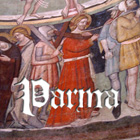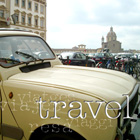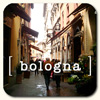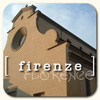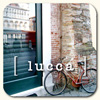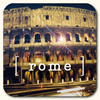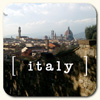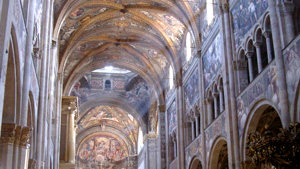
|
A HISTORY OF ANCIENT TRIBAL, IMPERIAL & RENAISSANCE FEUDS, RICH ARTISTIC TRADITION & A HIGH STANDARD OF LIVING Updated 2 June 2006 Famed for its cured ham and zesty cheese, Parma is a gracious Italian city. Oozing with quaint, delightful shops, restaurants and historical sites, this savory mini-metropolis wraps you in a wonder of old-school charm. There is a little bit of everything here, whether your tastes are musical or historical, Parma is an ideal place for a short weekend or a perfect day trip from nearby Bologna. Easily accessible by train, grab a book, some walking shoes and a pair of (fashionable) sunglasses, and out you go—all that is needed to enjoy a perfect, hushed day of discovery. Another of Italy’s famed medieval cities, but not an isolated hilltop fortress, and surrounded by modern expansion, Parma’s center offers an array of delights for the pedestrian. Named by French newspaper Le Monde as the best city for living in Italy, the city caters to visitors and residents alike with equal care and attention to good living. Although the more recent and rather bland, block-walled city expansion makes for a stark contrast to its visually enticing city center, there is enough to do and to see to please even the most discriminating visitor. Nestled along the Torrente Parma (Parma Torrent, or river), the old city’s small size of about 2 square miles invites you to sit down, relax and feel at home after just an hour’s stroll. Nicely punctuated with outdoor cafes, practically every point of interest in town can be followed by a short café break, or if you’re hankering for something a bit more savory, some antipasti and fresh pasta. Highly regarded for its cuisine, eating and drinking local treats is part of the culture, and surely part of any authentic Parma experience. The old city’s lure wades around the combined Piazza Pilotta and the Piazza della Pace. The flagship building on the simple, and surprisingly ample, grass-lawn park is the war-pocked Palazzo della Pilotta. Although the building’s façade leaves the architectural enthusiast in any of us in quizzical despair, it houses most of the city’s greatest works of art. In the complex you will find the Museo Archeologico Nazionale, the Teatro Farnese and the Galleria Nazionale, each with plenty to see. Begun in 1602 and bombed during in 1944, during the Second World War, it was named after a game, pelota, which was often played in the courtyard. Today, a summer air of sunbathing and picnics mingle with lovers strolling and mothers giving their children a taste of country life as they play across the dual piazzas’ flat, grassy fields. A rarity in Parma’s center, laced with cyclists, you needn’t fear a trampling or expect to hear the excited brrrring! of a bicycle bell, as even riders must dismount and walk here. One of Parma’s masterful expressions of renaissance art can be found in the Camera di San Paolo. It has been named the Camera di Correggio for his application of magnificent frescoes inside the apartment’s vault. Originally a convent, its owner, the humanistic Badessa Giovanna di Piacenza, commissioned Correggio and Alessandro Araldi to fresco the refectory and adjacent chamber in 1510. [Full Profile] |
||||||||||||||||||||||||
|
|||||||||||||||||||||||||
